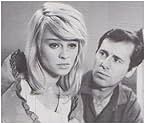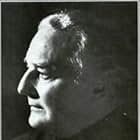In 1970, a team of scientists decrypts a mysterious signal from space with instructions to create a supercomputer. This in turn contains instructions to create a living organism.In 1970, a team of scientists decrypts a mysterious signal from space with instructions to create a supercomputer. This in turn contains instructions to create a living organism.In 1970, a team of scientists decrypts a mysterious signal from space with instructions to create a supercomputer. This in turn contains instructions to create a living organism.
Browse episodes
Photos
Storyline
Did you know
- TriviaLittle of this series remains. Until 2006, only approximately fifteen minutes (the fourth and fifth film reels) of the final episode survived, plus some clips including the titles. The sequel, The Andromeda Breakthrough (1962), survives in its entirety.
- Alternate versionsThe BBC created a tele-snap reconstruction of the series for a DVD box set release in 2006. It uses music from the series (the original soundtrack for the episodes is lost), the only surviving complete episode 6, "The Face of the Tiger," as well as the surviving clips from the remaining episodes, including fifteen minutes of the final episode
- ConnectionsFeatured in Torchwood: Random Shoes (2006)
Featured review
As a 12 year old, my parents considered it inappropriate for me to watch this nonsense, so I didn't get to see every episode when it first came out, and I had to content myself with reading the novelisation of "A4A" and its sequel "Andromeda Breakthrough". I'd heard that the BBC had destroyed all the prints (of A4A) although some episodes had been recovered, "The Face of the Tiger" (Ep 6) in its entirety.
So imagine my complete and utter amazement when yesterday I saw that the BBC was releasing both serials on DVD. I hied myself down the video shop this morning and lo and behold there they were. Sadly the missing episodes were still missing but using a technique called "Telesnap" which had involved somebody sitting in front of their TV taking a still photograph every time something interesting appeared on screen, and inserting captions taken from the script the entire story was reconstructed. There were also some short excerpts gained from various sources which were inserted.
The last two episodes were virtually complete.
So, I was introduced to (the late) Sir Fred Hoyle and his sometimes eccentric but always entertaining writing by this TV series, and a much wider world, so bless you Sir Fred.
It also inspired me with an almost fanatical dedication to computers that even as a 12 year old I wanted to own one. I bought my first one (Apple II) in 1979, and in 2007 I have them lying all over the floor and hanging on shelves.
Having finished watching the entire "A4A" and one episode of "Breakthrough", despite having had the novels since 1964 or so, I'm amazed how relevant the storyline and its ideas are. Genetic engineering. Human cloning. Climate change. Exploration, subjugation and even destruction of a foreign species by remote means. Tissue regeneration. Computers "taking over everything". Biological warfare. Middle Eastern oil!!! "Third World" nations becoming electronic sweatshops to increase their economic wealth. The list goes on.
The plot? It's almost exactly the same as "Contact" with Jodie Foster (or to be more pedantic, vice-versa). A radio telescope picks up a signal from space, it's decoded into a design for a "super computer", with a program and data. The computer starts working out what makes the earthlings tick. It creates a mass of protoplasm with an eye which enables the computer to see what's going on around it. Eventually the computer kills a girl and reads her DNA, then clones her, but she's actually part of the computer. And then the fun REALLY starts. interstellar/interspecies love story. World domination. Security of one nation's air space from hostile intrusion and threat.
The cast? First and foremost, the absolutely unbelievable Julie Christie in her first appearance in front of the camera. Although deliberately given a very limited emotional range to work within (she plays the protoplasmic computer) she is stunning both in looks, her icy menace and eventual (unintended) human frailty. (Susan Hampshire plays Andromeda in the Breakthrough and has a very difficult job to fill Jules' shoes - but she gives it a damned good go).
Peter Halliday as the rebellious but brilliant (probably unstable) physicist who tries to warn all and sundry of the danger.
Mary Morris as Madelaine Dawnay, the biologist who "creates" Andromeda.
I know almost every word by heart from reading the novels, but this DVD release gives me a refreshing re-view of this timeless classic.
Trivia: Julie Christie's character is created by a computer. In Demon Seed she is impregnated by a computer. Does she have a thing for electronic sex?
So imagine my complete and utter amazement when yesterday I saw that the BBC was releasing both serials on DVD. I hied myself down the video shop this morning and lo and behold there they were. Sadly the missing episodes were still missing but using a technique called "Telesnap" which had involved somebody sitting in front of their TV taking a still photograph every time something interesting appeared on screen, and inserting captions taken from the script the entire story was reconstructed. There were also some short excerpts gained from various sources which were inserted.
The last two episodes were virtually complete.
So, I was introduced to (the late) Sir Fred Hoyle and his sometimes eccentric but always entertaining writing by this TV series, and a much wider world, so bless you Sir Fred.
It also inspired me with an almost fanatical dedication to computers that even as a 12 year old I wanted to own one. I bought my first one (Apple II) in 1979, and in 2007 I have them lying all over the floor and hanging on shelves.
Having finished watching the entire "A4A" and one episode of "Breakthrough", despite having had the novels since 1964 or so, I'm amazed how relevant the storyline and its ideas are. Genetic engineering. Human cloning. Climate change. Exploration, subjugation and even destruction of a foreign species by remote means. Tissue regeneration. Computers "taking over everything". Biological warfare. Middle Eastern oil!!! "Third World" nations becoming electronic sweatshops to increase their economic wealth. The list goes on.
The plot? It's almost exactly the same as "Contact" with Jodie Foster (or to be more pedantic, vice-versa). A radio telescope picks up a signal from space, it's decoded into a design for a "super computer", with a program and data. The computer starts working out what makes the earthlings tick. It creates a mass of protoplasm with an eye which enables the computer to see what's going on around it. Eventually the computer kills a girl and reads her DNA, then clones her, but she's actually part of the computer. And then the fun REALLY starts. interstellar/interspecies love story. World domination. Security of one nation's air space from hostile intrusion and threat.
The cast? First and foremost, the absolutely unbelievable Julie Christie in her first appearance in front of the camera. Although deliberately given a very limited emotional range to work within (she plays the protoplasmic computer) she is stunning both in looks, her icy menace and eventual (unintended) human frailty. (Susan Hampshire plays Andromeda in the Breakthrough and has a very difficult job to fill Jules' shoes - but she gives it a damned good go).
Peter Halliday as the rebellious but brilliant (probably unstable) physicist who tries to warn all and sundry of the danger.
Mary Morris as Madelaine Dawnay, the biologist who "creates" Andromeda.
I know almost every word by heart from reading the novels, but this DVD release gives me a refreshing re-view of this timeless classic.
Trivia: Julie Christie's character is created by a computer. In Demon Seed she is impregnated by a computer. Does she have a thing for electronic sex?
- How many seasons does A for Andromeda have?Powered by Alexa
Details
- Runtime45 minutes
- Color
- Sound mix
- Aspect ratio
- 1.33 : 1
Contribute to this page
Suggest an edit or add missing content


























